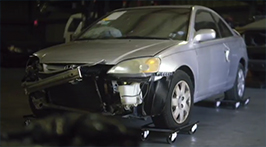Although knee replacement surgery was once a risky operation a decade ago, recent advancements in prosthetic technology have led to knee replacements that are safer and more functional than ever before. A knee replacement surgery involves a medical device that is designed to replace damaged bone and cartilage of the knee, with components made of plastic and metal to replicate the normal functions of the knee joint. Knee replacement surgery has helped thousands of patients resume normal lives, but a prosthetic knee is not designed to withstand high-impact activities like running or most sports.
Well over a quarter of a million total knee replacement surgeries are performed each year in the U.S., with 70 percent of these patients over the age of 65. The majority of patients undergo the surgery as a result of a specific injury or the deterioration of the joint that accompanies advanced age. The most common injuries requiring knee replacement surgery result from sports injuries and automobile crashes. Other patients discover that they eventually require total knee replacement due to the effects of advanced arthritis.
Defects in Knee Replacements
Despite the technological advancements behind modern prosthetic knees, there are still many cases of patients who have developed serious complications following total knee replacement surgery due to manufacturing defects present in the medical device. Due to the many intricate components that must fit together perfectly in a prosthetic knee, even the smallest manufacturing flaw can cause poor function and health complications in patients. One of the more serious defects found in knee replacements involves flaws that result in the eventual detachment or dislocation of the prostheses following surgery. Another common problem with knee replacement devices comes from design flaws that do not allow the device to fuse correctly with the patient’s leg bones.
Unfortunately, defective knee replacements can have a very negative impact on a patient’s health if they are not recalled from the market before they reach the public. For example, knee replacements that fail to bond correctly to human bones can cause severe pain, repeated surgeries, and long periods of postoperative recovery. Some prosthetic knees are well designed to heal properly and restore knee function but are constructed of materials that do not properly withstand the progression of time, leading to the need for unnecessary revision surgery in the future.
Although 90 percent of all patients who undergo total knee replacement experience minimal or no complications and have significantly improved knee function, not every implant goes so smoothly. The remaining 10 percent will require revision surgery as a result of defective knee replacements or other complications in the 10 years following their surgery.
Recalls of Knee Replacements
In February 2008, the New Jersey-based prostheses manufacturer Stryker Howmedica Osteonics Corporation issued a voluntary recall of various model sizes of their Stryker Modular Replacement System Curved Cemented Stem due to a minor discrepancy between the devices that were used for medical trials and those that were used for implants. The discrepancy concerned the radius of the curvature of a particular component of the medical device that could cause serious complications if implanted in patients. In this case, the knee replacement components were removed from market before anyone was harmed.
However, in the case of the 2004 recall of Press Fit zirconium knees by Smith and Nephew Inc., the knee replacements had been implanted in a large number of patients before it was discovered that some of the prostheses were failing to bond with the patient’s bones during the recovery process. Although Smith and Nephew released an immediate recall once the flaws were discovered, they were not alerted to the problem until they received reports of defective prostheses from patients and health care providers. As a result, patients were required to undergo additional surgeries and experience more pain and immobility during their recovery period than necessary.
Sources:
- http://orthoinfo.aaos.org/topic.cfm?topic=A00389
- http://www.nlm.nih.gov/medlineplus/kneereplacement.html
- http://www.accessdata.fda.gov/scripts/cdrh/cfdocs/cfres/res.cfm?id=66564
- http://www.accessdata.fda.gov/scripts/cdrh/cfdocs/cfres/res.cfm?start_se…
- http://www.accessdata.fda.gov/cdrh_docs/pdf9/K090705.pdf
- http://www.accessdata.fda.gov/scripts/cdrh/cfdocs/medsun/medsun_details….
- http://catalog.nucleusinc.com/displaymonograph.php?MID=176
